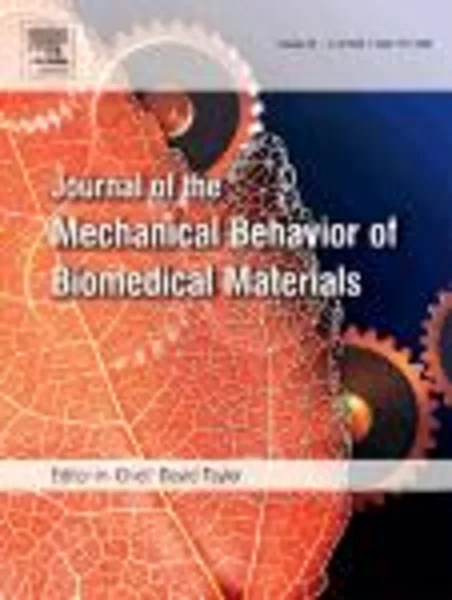-
poro-viscoelastic constitutive modeling of unconfined creep of hydrogels using finite element analysis with integrated optimization method
جزئیات بیشتر مقاله- تاریخ ارائه: 1394/01/01
- تاریخ انتشار در تی پی بین: 1394/01/01
- تعداد بازدید: 641
- تعداد پرسش و پاسخ ها: 0
- شماره تماس دبیرخانه رویداد: -
hydrogels are cross-linked polymer networks swollen with water and are being considered as potential replacements for deceased load bearing tissues such as cartilage. hydrogels show nonlinear time dependent behavior, and are a challenge to model. a three-element poro-viscoelastic constitutive model was developed based on the structure and nature of the hydrogel. to identify the material parameters, an inverse finite element (fe) technique was used that combines experimental results with fe modeling and an optimization method. unconfined compression creep tests were conducted on poly(vinyl alcohol) (pva) and poly(ethylene-co-vinyl alcohol)–poly(vinyl pyrrolidone) (eval–pvp) hydrogels manufactured by injection molding. results from the creep experiments showed that for pva hydrogels, an increase in polymer concentration correlates with a decrease in the equilibrium water content (ewc) and the creep strain. in eval–pvp hydrogels, an increase in the hydrophobic segments (eval) correlates with a decrease in the ewc as well as the creep strain. an inverse fe method was used to identify the viscoelastic material parameters of the hydrogels in combination with creep testing using the poro-viscoelastic three-element constitutive model. the elastic modulus estimated from the inverse fe technique showed good agreement with the modulus estimated directly from the test data.
مقالات جدیدترین رویدادها
-
استفاده از تحلیل اهمیت-عملکرد در ارائه الگوی مدیریت خلاقیت سازمانی و ارائه راهکار جهت بهبود
-
بررسی تاثیر ارزش وجوه نقد مازاد بر ساختار سرمایه شرکت های پذیرفته شده در بورس اوراق بهادار تهران
-
بررسی تأثیر سطح افشای ریسک بر قرارداد بدهی شرکت های پذیرفته شده در بورس اوراق بهادار تهران
-
بررسی تأثیر رتبه بندی اعتباری مبتنی بر مدل امتیاز بازار نوظهور بر نقد شوندگی سهام با تأکید بر خصوصی سازی شرکت ها
-
تأثیر آمیخته بازاریابی پوشاک ایرانی بر تصویر ذهنی مشتری پوشاک ایرانی (هاکوپیان)
-
اهمیت استراتژی مدیریت اکوسیستم در منطقه گردشگری دریای عمان
-
بررسی منشا گارنت های موجود در گرانودیوریت های منطقه دهنو، شمال غرب مشهد، استان خراسان رضوی
-
نقش سرمایه فکری در بهبود فرآیندهای اقتصادی
-
مقایسه تأثیر لیزر کم توان و اولتراسوند در مبتلایان به سندرم درد عضلانی- فاشیایی
-
effect of (zn(oh)2)3(znso4)(h2o)5 on the performance of ru–zn catalyst for benzene selective hydrogenation to cyclohexene
مقالات جدیدترین ژورنال ها
-
مدیریت و بررسی افسردگی دانش آموزان دختر مقطع متوسطه دوم در دروان کرونا در شهرستان دزفول
-
مدیریت و بررسی خرد سیاسی در اندیشه ی فردوسی در ادب ایران
-
واکاوی و مدیریت توصیفی قلمدان(جاکلیدی)ضریح در موزه آستان قدس رضوی
-
بررسی تاثیر خلاقیت، دانش و انگیزه کارکنان بر پیشنهادات نوآورانه کارکنان ( مورد مطالعه: هتل های 3 و 4 ستاره استان کرمان)
-
بررسی تاثیر کیفیت سیستم های اطلاعاتی بر تصمیم گیری موفق در شرکتهای تولیدی استان اصفهان (مورد مطالعه: مدیران شرکتهای تولیدی استان اصفهان)
-
مطالعه تاثیر بانکداری الکترونیکی بر نیت رفتاری مصرف کنندگان در صنعت بانکداری
-
بررسی درآمدهای مالیاتی خراسان شمالی و ارتباط بین درآمد مصوب شده و عملکرد از سال 90-96
-
نقش توان مندی مدیران در کشف کلاه برداری گزارشگری مالی با در نظر گرفتن حضور و نفوذ صاحب منصبان دولتی در ارکان اداره شرکت ها با تعیین درجه سیاست دولتی بر اساس شاخص sa
-
surface adsorption of carbon monoxide and hydrogen gases mixed with boron nitride (7 ,7) nanotubes by monte carlo method
-
the effects of employees’ integrity, responsibility, compassion and forgiveness on corporate social responsibility in iranian private sector in east and west of azerbaijan in iran




سوال خود را در مورد این مقاله مطرح نمایید :